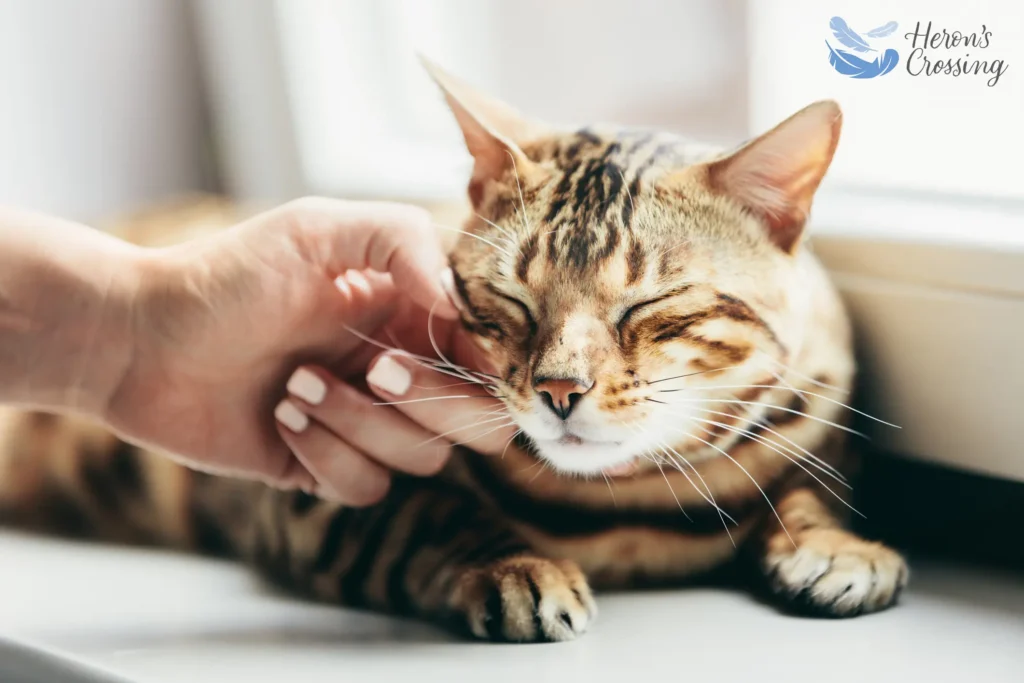We pet parents believe that the cute, raspy sound of a cat purring is a sign of blissful contentment. Yes, but that’s only part of the story.
Purring can be a reaction to a range of emotional situations, from pleasure, to anxiety, to distress.
Researchers say cats do this involuntarily. The sound is made by the vibration of muscles around the cat’s vocal cords, but not the cords themselves. So a cat can purr and meow at the same time, which can come in handy at dinner time, when she will be doing her utmost to get your attention. Cats also purr both while inhaling or exhaling.
Conditions when cats purr:
- As a mother cat is giving birth or nursing her kittens. She may be self-soothing, or helping her body physically in some way, and she could be communicating with her kittens by vibration, since kittens can’t see or hear for several days after they are born.
- Kittens as young as two days purr during feedings.
- When greeting another person or animal with uncertainty.
- When feeling anxious or frightened.
- When they are feeling content and comforted. We may be substitutes for their mother even more than we realize.
- When begging for food – louder and more urgently. This is behavior learned as a kitten.
- Self-soothing when upset, angry, sick or in pain. They may be mimicking the mother’s sounds.
- During sleep, perhaps to self-heal.
Purring ranges from 25 to 150 Hertz. Researchers have learned that resonating at these frequencies can promote both tissue and bone healing in a cat. Bone tissue begins to strengthen at 20-50 Hertz, while skin and soft tissues respond to 100 Hertz.
Because astronauts lose bone density and muscle during long space flights, scientists are considering mimicking this kind of cat resonance to regenerate the body, perhaps during sleep.
The urgent ‘feed me’ purr can go up as high as 200-520 Hertz. Researchers say that’s in the range of a human baby’s cries, and may elicit the same kind of distress within us to take care of our furry baby immediately.
Your cat’s body language can tell you what kind of purring it is. If she’s relaxed, it’s a happy purr. If she is hunched, ears back, drawing her body and tail inward, or slapping her tail, she could be upset or in pain. This kind of purring alerts you to a problem that may require a trip to your vet for a checkup.
Each cat has its own style of purring that never changes. If you have a talkative cat, you’re more likely to have one that purrs a lot. Feral cats also purr. But when it comes to ‘the big cats’ there is a difference.
Wildcat Sanctuary officials say purring ability is one of the two factors that separates the genuses of cats, along with whether their pupils contract into a vertical slit or a circle. They are classified as either ‘purring cats’ or ‘roaring cats,’ but they can’t be both.
The smaller wildcats like bobcats and cougars (a.k.a. panthers or mountain lions) can purr. But bigger cats have muscles, hyoid bones and vocal chords that are too strong to vibrate. That incredible strength is what makes them able to roar so loudly.
Incidentally, there is one big cat that can purr. The cheetah purrs and meows like a house cat – and chirps like a bird. So she is in a classification all by herself. Click here to listen to the cheetah chirp.
Take some time to listen to your little feline. Notice the range of sounds she makes, and when she makes them. Listen not only for her type of purring, but for all the little grunts, squeaks, chirps and ‘thrups’ and ‘chuffs’ that make your cat unique and precious.
Should you purr back? No. You may be sending the wrong message. Just pet her.
Heron’s Crossing provides end-of-life care for pets in the Metro Atlanta area. In-home appointments with compassionate vets are available. If you’d prefer a home-like setting away from your home, our Decatur office is also available by appointment.

